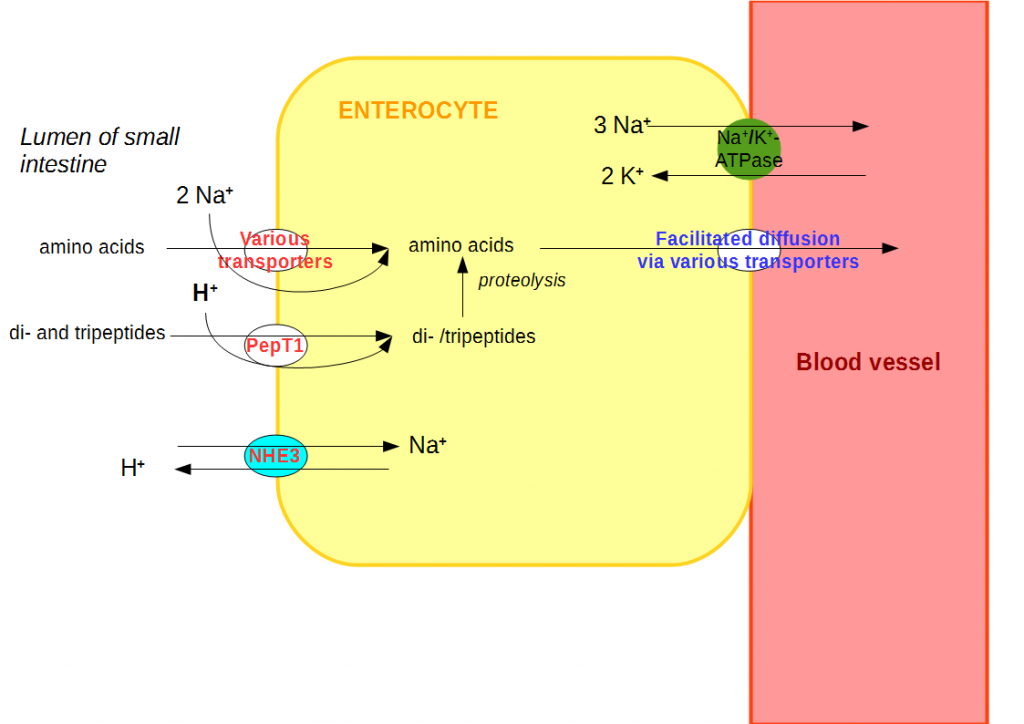
Physiology
Gastrointestinal
Regarding protein digestion, which of the following statements is CORRECT:
Answer:
Digestion of dietary protein begins in the stomach where pepsin hydrolyses protein to polypeptides, and continues in the duodenum where pancreatic proteases (trypsin and chymotrypsin) continue the process of hydrolysis forming oligopeptides. These are further broken down into small peptides and amino acids by pancreatic carboxypeptidases and aminopeptidases located on luminal membrane epithelial cells. Free amino acids are absorbed across the apical membrane by secondary active transport coupled with Na+ transport into the cell. Amino acids cross the basal membrane into the capillaries by facilitated diffusion.Protein Handling
Physiology / Gastrointestinal / Small Intestine
Last Updated: 26th July 2024
Protein is composed of amino acids linked by peptide bonds. Nine amino acids are essential (required from the diet) for protein synthesis and nitrogen balance, the other necessary amino acids can be manufactured in the body. Proteins provide about the same amount of energy as carbohydrate but are not as easily utilised. The protein requirement of a normal healthy adult is about 40 g/day. Protein is digested in the stomach and small intestine.
Protein Digestion
Digestion of dietary protein begins in the stomach where pepsin hydrolyses protein to polypeptides, and continues in the duodenum where pancreatic proteases (trypsin and chymotrypsin) continue the process of hydrolysis forming oligopeptides.
These are further broken down into small peptides and amino acids by pancreatic carboxypeptidases and aminopeptidases located on luminal membrane epithelial cells. Free amino acids are absorbed by secondary active transport coupled with Na+ transport. Amino acids cross the basal membrane into the capillaries by facilitated diffusion.

Protein Handling. (Image by Sonabi (Own work) [CC BY-SA 4.0 , via Wikimedia Commons)
Report A Problem
Is there something wrong with this question? Let us know and we’ll fix it as soon as possible.
Loading Form...
- Biochemistry
- Blood Gases
- Haematology
| Biochemistry | Normal Value |
|---|---|
| Sodium | 135 – 145 mmol/l |
| Potassium | 3.0 – 4.5 mmol/l |
| Urea | 2.5 – 7.5 mmol/l |
| Glucose | 3.5 – 5.0 mmol/l |
| Creatinine | 35 – 135 μmol/l |
| Alanine Aminotransferase (ALT) | 5 – 35 U/l |
| Gamma-glutamyl Transferase (GGT) | < 65 U/l |
| Alkaline Phosphatase (ALP) | 30 – 135 U/l |
| Aspartate Aminotransferase (AST) | < 40 U/l |
| Total Protein | 60 – 80 g/l |
| Albumin | 35 – 50 g/l |
| Globulin | 2.4 – 3.5 g/dl |
| Amylase | < 70 U/l |
| Total Bilirubin | 3 – 17 μmol/l |
| Calcium | 2.1 – 2.5 mmol/l |
| Chloride | 95 – 105 mmol/l |
| Phosphate | 0.8 – 1.4 mmol/l |
| Haematology | Normal Value |
|---|---|
| Haemoglobin | 11.5 – 16.6 g/dl |
| White Blood Cells | 4.0 – 11.0 x 109/l |
| Platelets | 150 – 450 x 109/l |
| MCV | 80 – 96 fl |
| MCHC | 32 – 36 g/dl |
| Neutrophils | 2.0 – 7.5 x 109/l |
| Lymphocytes | 1.5 – 4.0 x 109/l |
| Monocytes | 0.3 – 1.0 x 109/l |
| Eosinophils | 0.1 – 0.5 x 109/l |
| Basophils | < 0.2 x 109/l |
| Reticulocytes | < 2% |
| Haematocrit | 0.35 – 0.49 |
| Red Cell Distribution Width | 11 – 15% |
| Blood Gases | Normal Value |
|---|---|
| pH | 7.35 – 7.45 |
| pO2 | 11 – 14 kPa |
| pCO2 | 4.5 – 6.0 kPa |
| Base Excess | -2 – +2 mmol/l |
| Bicarbonate | 24 – 30 mmol/l |
| Lactate | < 2 mmol/l |

